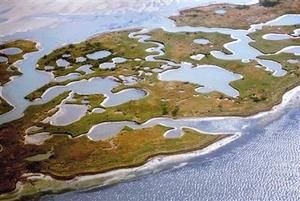Katrina: five years onAre New Orleans' storm defenses strong enough?
The U.S. Army Corps of Engineers has invested $14.45 billion in bolstering New Orleans’ defenses against storms, and there is a consensus that the city’s protection now is better than they were on 29 August 2005, when Katrina made landfall, and its 8.5-meter surge went on to overpower a poorly constructed and poorly connected levees and flood walls; critics say, though, that the better designed and built levees do not take into account the stronger hurricanes which climate changes causes, and that the best defenses against hurricanes — coastal marshes, wetlands, and barrier islands — are being eroded and lost at an alarming rate as a result of urban development and the Corps’ own engineering approach to harnessing and taming the Mississippi River

Barrier islands off New Orleans // Source: msn.com
It is almost five years since hurricane Katrina devastated New Orleans, and the city is bracing for other attacks to come. In a revamp now nearing completion, the city’s 560-kilometer perimeter has been fortified by toughened levees, cement walls more than 9-meters high, and impising gates that will grind shut when flood water nears (“New levee design, construction materials tested in Louisiana,” 23 August 2010 HSNW).
Some say that these upgraded defensces, which cost the U.S. federal government $14.45 billion, are not tough and comprehensive enough — in part because climate change lead to more powerful storms.
Sujata Gupta writes in New Scientist that the city is certainly safer than it was on 29 August 2005, when Katrina made landfall. Its 8.5-meter surge went on to overpower a poorly constructed and poorly connected levees and flood walls.
Now those walls have been replaced with steel-reinforced ones shaped like an inverted “T,” making it harder for a storm surge to topple them, says Gregory Gunter, an officer with the U.S. Army Corps of Engineers, the agency overseeing the revamp.
The mud levees that Katrina washed away are now bolstered with stronger clays, while pump stations come with flood-proof safe houses so operators will not have to evacuate like they did in 2005.
All this should protect the city from the kind of storm that historically has occurred once in 100 years. The system should not fail in a “400-year” Katrina-strength storm either, although Gunter says such a surge would probably flow over the barriers. This would lead to some flooding, but nothing like the scale of Katrina, which pushed over walls and breached levees.
Robert Bea, an engineer at the University of California, Berkeley, and long-time critic of the corps’s flood defenses, says the United States is still “doing it on the cheap.”
He contrasts the new defenses with those that protect the Netherlands, which can withstand a 10,000-year storm. The Dutch “know that providing adequate flood protection [costs] something in the range of $100 billion”, he says.
Paul Kemp, director of the National Audubon Society’s Louisiana Coastal Initiative in Baton Rouge, and former storm surge modeler, says the new designs presume that future storms will resemble past ones. He points out that climate change may increase hurricane strength.
Gupta notes that this suggestion is still a subject of hot debate. In any case, Kemp would have liked to see restoration of Louisiana’s coastal marshes, which absorb some of a storm surge’s bite. He thinks they are likely to be more resilient than artificial structures. He adds that the destructive threat posed by hurricanes is also increasing because the buffering wetlands are constantly being destroyed.
While the corps has begun looking into coastal restoration as a way to protect the city, as yet no money has been set aside for this.
Kemp also calls the idea of a 100-year storm a “mythical measure,” pointing out that we only have about 100 years of reliable data to work with, which is not necessarily enough to reflect long-term hurricane patterns.
